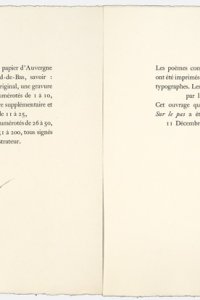Sur le pas
Year: 1959
Author: André du Bouchet (1924 - 2001)
Artist: Pierre Tal-Coat (1905 - 1985)
Publisher: Maeght éditeur
Tal-Coat
Due to his close collaboration with painters he had befriended such as Giacometti, Bram van Velde, but mostly Pierre Tal-Coat, Du Bouchet's poems gained an additional dimension. Du Bouchet loved painting that balanced on the edge of abstraction, and Tal-Coat excelled at that. Painter Pierre Jacob, who was originally from Brittany, was over twenty years older than Du Bouchet. In 1926, he decided to adopt the name Tal-Coat as a pseudonym in order to avoid being confused with painter and poet Max Jacob. Tal-Coat first met Du Bouchet around 1948. They would spend a great deal of time as friends working together and exchanging ideas about poetry and painting.
Space
A light-blue slipcase protects this edition of Sur le pas, with sixteen original aquatints and nine poems in a bright-yellow cover with a black painting that suggests (foot)steps. The deluxe edition was published by gallery and publisher Maeght. Its unusual size (of 42 cm!) is striking at first sight. Because of the 'space' theme, this large size was undoubtedly also something Du Bouchet and Tal-Coat had desired specifically. Tal-Coat's aquatints – in expressive colours and two-page spreads – in Sur le pas 'breathe' through Du Bouchet's margins and white lines, as though they represent the poems' lungs.
The rooster on the fish
The paper on which the illustrations and text are printed is hand-made Richard de Bas. This paper is produced in the eponymous paper mill in the Auvergne (France). Attentive readers will notice two unusual watermarks, namely: a rooster on a fish, and the name Richard de Bas with a crossed-out heart and the year 1326 above it. That was the year when the mill of this unique paper mill, which is still active to this day, first became operational.
Bibliographical description
Bibliography: Sur le pas / André du Bouchet ; [aquatintes originales de] Pierre Tal-Coat ; – Paris: Maeght éditeur, 1959. - [57] p. : ill. ; 42 cm
Printer: Fequet et Baudier (text), Crommelynck (original watercolours)
Edition: 200 copies
This copy: Number 119 of 200 on Auvergne Richard-de-Bas
Typeface: Elzévir Caslon
Note: Signed by the author and the artist
Bibliography: Bénézit 13-441 ; Monod 3956
Shelfmark: KW Koopm E 59
References
- Michael Bishop, 'André du Bouchet et l'autre de l'esthétique: Segers, Poussin, Tal-Coat', in: Philippe Met, André du Bouchet et ses autres. Paris, Lettres Modernes Minard, 2003, p. 109-127
- Michael Bishop, 'Tal-Coat: écart et réciprocité, silence et reconnaissance', in: Altérités d'André du Bouchet. Amsterdam, Rodopi, 2003, p. 73-81
- Pierre Chappuis, André du Bouchet. Paris, Seghers, 1979
- Raymond Cogniat, 'Tal-Coat', in: George Besson, Desnoyer, Walch, Tal-Coat, Pignon, Gruber, Fougeron. Souillac (Lot.), Mulhouse, 1947, p. 21-27
- Michel Collot, Autour de André du Bouchet: actes du colloque des 8, 9, 10 décembre 1983. Paris, Presses de l'École Normale Supérieure, 1986
- Jacques Depreux, André du Bouchet ou la parole traversée. Seyssel, Champ Vallon, 1988
- Henri Maldiney, 'Introduction à Tal-Coat', in: Les temps modernes 5 (1949), p. 988-1008
- Yves Peyré, 'Pierre Tal-Coat et le livre', in: Revue de la Bibliothèque Nationale, 5 (1985) 18, p. 12-17
![Sur le pas, titelpagina met frontispice (p. [4-5])](/sites/default/files/styles/paragraph_small_no_crop/public/images/sur-le-pas-p4-5.jpg?itok=OqbmEqzO)
![Fragment van aquatint door Tal-Coat (p. [20]-[21])](/sites/default/files/styles/galerie/public/images/sur-le-pas-p20-21.jpg?h=6566fe67&itok=Rt94aEOz)
![Tekst van Du Bouchet met aquatint door Tal-Coat (p. [36-37])](/sites/default/files/styles/galerie/public/images/sur-le-pas-p36-37.jpg?h=2052151d&itok=bSBSoZ_q)
